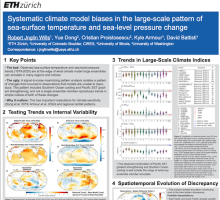Systematic Climate Model Biases in the Large-Scale Patterns of Recent Sea-Surface Temperature and Sea-Level Pressure Change
Robert
Jnglin Wills
ETH Zurich
Poster
Observed surface temperature trends over recent decades are characterized by (a) intensified warming in the Indo-Pacific Warm Pool and slight cooling in the eastern equatorial Pacific, consistent with Walker circulation strengthening, and (b) Southern Ocean cooling. In contrast, state-of-the-art coupled climate models generally project enhanced warming in the eastern equatorial Pacific, Walker circulation weakening, and Southern Ocean warming. Here we investigate the ability of 16 climate model large ensembles to reproduce observed sea-surface temperature and sea-level pressure trends over 1979–2020 through a combination of externally forced climate change and internal variability. We find large-scale differences between observed and modeled trends that are very unlikely (<5% probability) to occur due to internal variability as represented in models. We use a signal-to-noise maximizing pattern analysis to isolate the patterns of observed sea-surface temperature (SST) and sea-level pressure (SLP) changes that climate models do not reproduce. Disparate trends in the ratio of Indo-Pacific Warm Pool to tropical-mean warming, which shows little multi-decadal variability in models, hint that model biases in the response to historical forcing constitute part of the discrepancy.
In addition to the published work described in the above abstract, we will present highlights of ongoing work to investigate the relationship between the SST and SLP trend biases with (i) climatological SST biases and (ii) precipitation trends.
In addition to the published work described in the above abstract, we will present highlights of ongoing work to investigate the relationship between the SST and SLP trend biases with (i) climatological SST biases and (ii) precipitation trends.

Poster file
